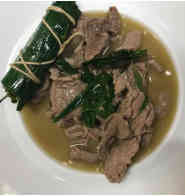| Style Transfer Applied To Cooking - The Case Of The French Sukiyaki |
| Written by Lucy Black | |||
| Sunday, 14 May 2017 | |||
|
We have seen AI used for style transfer in the world of painting and photography, but what about cooking? What would a classic dish in one cuisine look like, or rather taste like, in another? This is the question that Masahiro Kazama, Minami Sugimoto, Chizuru Hosokawa, Keisuke Matsushima, Lav R. Varshney, and Yoshiki Ishikawa attempt to answer and, given that one of them admits to being a professional chef, the interest may not be just purely academic. We propose a novel system which can transform a recipe into any selected regional style (e.g., Japanese, Mediterranean, or Italian). This system has three characteristics. First the system can identify the degree of dietary style mixture of any selected recipe. Second, the system can visualize such dietary style mixtures using barycentric Newton diagrams. Third, the system can suggest ingredient substitutions through an extended word2vec model, such that a recipe becomes more authentic for any selected dietary style. Drawing on a large number of recipes from Yummly, an example shows how the proposed system can transform a traditional Japanese recipe, Sukiyaki, into French style. This isn't style transfer as used in visual style transfer. A neural network is trained to recognize the ingredients and style of a particular country's cuisine. This can be used to predict the probability that a particular list of ingredients corresponds to a recipe in a particular cuisine. This makes it possible to plot charts that show how cuisines vary, but it doesn't give you a good way to change a recipe from one country to another. To do this the team trained a word2vec system. This is a neural network that places words into a vector space so that they are close to words with the same meaning, or rather role, in sentence constructions. The advantage of this is that you can write "word equations" to specify what you want. The example that is generally used is that if you feed word3vec "King-Man+Woman" you get Queen as the output. In the case of recipes you use equations like "Soy sauce-Japan+French" to find out what the French substitute for soy would be. The top ingredients for identifying a country are: Sadly the only example of recipe translation given is Sukiyaki into French.: As an example of our proposed system, we transformed a traditional Japanese Sukiyaki into French style. Table 3 shows the suggested replaceable ingredients and the probability after replacing. “Sukiyaki” consists of soy sauce, beef sirloin, white sugar, green onions, mirin, shiitake, egg, vegetable oil, konnyaku, and chinese cabbage.
Table 3: Alternative ingredients suggested by extended word2vec model and country probability of changing food ingredients in order from the top. Professional chef KM, who is one of the coauthors of this paper, chose one alternative ingredient from top 10 suggested ingredients each.
Clearly there is scope here for recipe translation to create new recipes but it also casts light on the natural variations within a cuisine: For example, should Fish Provencal, whose recipe name is suggestive of Southern France, be cast as French style? The answer is mixture of different country styles: 32% French; 26% Italian; and 38% Spanish. Of course, limiting the study to just the ingredients means that the typical cooking styles of each cuisine are not captured. However, it does leave the actual realization of the dish to the chef and this might just produce a better result.
More InformationSukiyaki in French style: A novel system for transformation of dietary patterns Related ArticlesDeep Learning Applied To Natural Language //No Comment - Kissing Cuisines To be informed about new articles on I Programmer, sign up for our weekly newsletter, subscribe to the RSS feed and follow us on Twitter, Facebook or Linkedin.
Comments
or email your comment to: comments@i-programmer.info |
|||
| Last Updated ( Sunday, 14 May 2017 ) |





